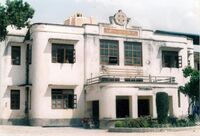Biography:Daya Bir Singh Kansakar
Daya Bir Singh Kansakar (Nepali: दयावीरसिंह कंसकार; 1911 – 5 February 2001, Kathmandu, Nepal) was a Nepalese social worker and the first blood donor in Nepal. also the chief founder of Paropakar Organization, the country's earliest social service organization.[1][2]
Early life
Kansakar was born in Kathmandu. His father, Bhawani Bir Singh Kansakar, was a trader. His mother was named Laxmi Devi. Kansakar studied up to Class 8 at Durbar High School in Kathmandu, and then took up self-study at home. He went to Chandra Laxmi Tuladhar of Nhyokha in 1927.[3][4]
Social work
In 1944, Kansakar donated blood at Bir Hospital in Kathmandu for a patient who was in a critical state, and became Nepal's first blood donor.[5] He continued to engage in social work, distributing free medicines to the needy. On 26 September 1947, Paropakar was formed under his leadership with the aim of providing service in an institutional manner.[6]
After the revolution of 1951 and the advent of democracy in Nepal, the Paropakar Organization expanded its sphere of activities. On 23 June 1952, Paropakar Orphanage was established. That same year, Paropakar Orphanage Middle School opened.[7][8]
Kansakar worked to set up Paropakar Indra Rajya Laxmi Devi Prasuti Griha maternity hospital in Kathmandu. Popularly known as Prasuti Griha, it is Nepal's first maternity hospital and opened on 26 September 1959.[9] Kansakar was an advocate of homespun, and set up Karuna Kapa Factory to produce traditional Nepalese cloth. He was also a writer and has produced a number of literary works in Nepal Bhasa.[10]
Honors
Kansakar was recognised as a Role Model Volunteer at the celebration of the International Volunteer Day (IVD) and closing ceremony of International Year of Volunteers 2001 (IYV) in Kathmandu.[11] The Postal Service Department of the government of Nepal issued a commemorative postage stamp depicting Kansakar's portrait in 2002.[12]
He has also been decorated with the Order of Gorkha Dakshina Bahu, Second Class (previously Fourth Class), and the Order of Tri Shakti Patta by the king of Nepal.[13] In 1963, he was named a member of the Privy Council (Raj Sabha).[14] President of Nepal Ram Baran Yadav issued a message on the occasion of the centenary of his birth saying that Kansakar's philanthropic services would always be remembered.[15]
References
- ↑ Shakya, Utsav (October 2011). "The legacy of Daya Bir Singh Kansakar". ECS Nepal. http://ecs.com.np/features/the-legacy-of-daya-bir-singh-kansakar. Retrieved 16 March 2012.
- ↑ Limbu, Ramyata (6–12 July 2001). "It is better to give". Nepali Times. http://himalaya.socanth.cam.ac.uk/collections/journals/nepalitimes/pdf/Nepali_Times_050.pdf. Retrieved 18 March 2012. Page 4.
- ↑ "Biography of Mr. Dayabir Singh Kansakar". Paropakar Sanstha (Organisation). 2011. http://paropakar.org/short_biography.htm. Retrieved 16 March 2012.
- ↑ Shrestha, Vinod K. and Aditya, Anand (2002). Volunteerism in Nepal. National Planning Commission, National Volunteers Service. ISBN:9993370134, 9789993370130. Page 141.
- ↑ Institute for Integrated Development Studies, Institute for Integrated Development Studies (Kathmandu, Nepal) (2003). Nepal Yearbook. Institute for Integrated Development Studies. Pages 96-97.
- ↑ Uprety, Prem (2000). "The Spirit of 1950: A Social Analysis". Voice of History (Nepal Journals Online) 15 (1): 21. http://www.nepjol.info/index.php/VOH/article/view/67/60. Retrieved 17 August 2013.
- ↑ Yadama, Gautam N.; Messerschmidt, Don (2002). "Rise and Fall of National Service in Nepal". https://docs.google.com/viewer?a=v&q=cache:dDPEezz5-rIJ:clayss.org.ar/ianys/INFORM/sasia_eng.doc+daya+bir+singh+kansakar&hl=en&pid=bl&srcid=ADGEESgXmChSLAjaxb2uUTrk3ljs6dPkgNrnIAgrjqB60VnWpOTVtBm9Yh8rrIAJxTadAFF-qvKUZUi1rP9EhAb7WjkRLJQ-OaGs4GJ3-il8j8J5mkjhAy_BvQFM9JQHTLhGmfqMa4fr&sig=AHIEtbQ8SQFbvI4DtPGK7GK3wJArx5a5YA. Retrieved 16 March 2012. Page 3.
- ↑ Limbu, Ramyata (16–22 February 2001). "Bahadur Nepali". Nepali Times. http://www.nepalitimes.com.np/issue/2001/02/16/Nation/9530. Retrieved 16 March 2012.
- ↑ "Prasuti Griha". Nepali Times. 2–8 March 2001. http://www.nepalitimes.com.np/issue/32/DomesticBrief/8438. Retrieved 13 August 2012.
- ↑ Shaky, Utsav (October 2011). "The legacy of Daya Bir Singh Kansakar". ECS Nepal. http://ecs.com.np/features/the-legacy-of-daya-bir-singh-kansakar. Retrieved 16 March 2012.
- ↑ "IVD/IYV 2001 Celebration Programme". Closing Ceremony of IYV 2001 in Nepal and Celebration of IVD 5th December. UN Volunteers. 2001. http://www.worldvolunteerweb.org/fileadmin/docs/old/pdf/2002/05_12_01NPL_IVD_IYV2001_closingreport.pdf. Retrieved 22 March 2012.
- ↑ "NP017.02". Universal Postal Union. http://www.wnsstamps.ch/en/stamps/NP017.02. Retrieved 16 March 2012.
- ↑ "Biography of Mr. Dayabir Singh Kansakar". Paropakar Sanstha (Organisation). 2011. http://paropakar.org/short_biography.htm. Retrieved 16 March 2012.
- ↑ Shakya, Utsav (October 2011). "The legacy of Daya Bir Singh Kansakar". ECS Nepal. http://ecs.com.np/features/the-legacy-of-daya-bir-singh-kansakar. Retrieved 3 January 2014.
- ↑ RSS (5 May 2011). "Golden jubilee celebration of philanthropist Kansakar begins". The Himalayan Times. http://www.thehimalayantimes.com/rssReference.php?headline=Golden+jubilee+celebration+of+philanthropist+Kansakar+begins&NewsID=286774. Retrieved 16 March 2012.
 |




